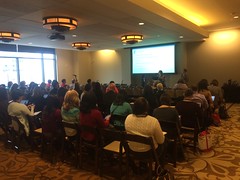
Wiley offers the entire collection or subject collections for a set access fee based on FTE tiers. At the end of the access period, titles up to (or for additional cost) exceeding the access fee are selected for perpetual access. Usage data is provided to help with selection.
Speaker: Galadriel Chilton, University of Connecticut
In general, ebook borrowers like public library books, but the formats of many academic ebooks is frustrating. If ebooks are not integrated with journal content, they are often not found or not found as easily. Convenience is key. There’s also the issue of unencrypted usage data being transmitted by Adobe, which is now being transmitted “securely,” but still profiling the reading habits of users.
They started the EBA with Wiley in April, and they saw a jump in usage before the titles were even in the catalog or discovery service. They were finding it on the platform already.
Downsides: Some content is only available on aggregator platforms, rather than Wiley’s platform. Some content is not included in the EBA program. Also, this adds another wrinkle to an already complicated ERM ecosystem.
It’s not an all-encompassing solution, but it is an ebook collection method that has significantly improved user experience.
Speaker: Monica Metz-Wiseman, University of South Florida
About 15% of the audience still has an approval plan. About 40% have a declining monographic budget. About 70% have declining monographic circulation.
They haven’t had an approval plan in 2009, have had a 50% drop in print circulation since 2008, and now rely on ebook packages and PDA (with STL).
They looked at STL costs in 2013 and saw that Wiley and Taylor & Francis were at the top. They decided to try the EBA with Wiley.
They wanted to recalibrate access with ownership. They wanted increased control over costs and content. They wanted to make sure the books would still be there later when a faculty member went looking for it (not always the case with PDA).
Challenges: The collection specialists were already removed from the collection process with PDA, and this was just another stake in the heart. There are two platform for Wiley collections, so they are having to maintain some of the titles on EBL still. The MARC records are not always good, requiring some manual fixes. Scalability is going to be challenging if there isn’t enough staff support. Funding uncertainty may make sustainability difficult, as well.
Benefits: Content integration, preferred DRM features, easier authentication, holding the line on price increases for STL and aggregator ebooks, and increased familiarity with Wiley content.
Selections were made on absolute use, without consulting subject specialists. They did not look to see if there were print copies available in the library already.
Not sure what impact this will have on ebook pricing in the future when publishers have more data about what users want.
Speaker: Robert Murdoch, Brigham Young University
He has prettier slides, but not much to say that wasn’t covered by the others.





